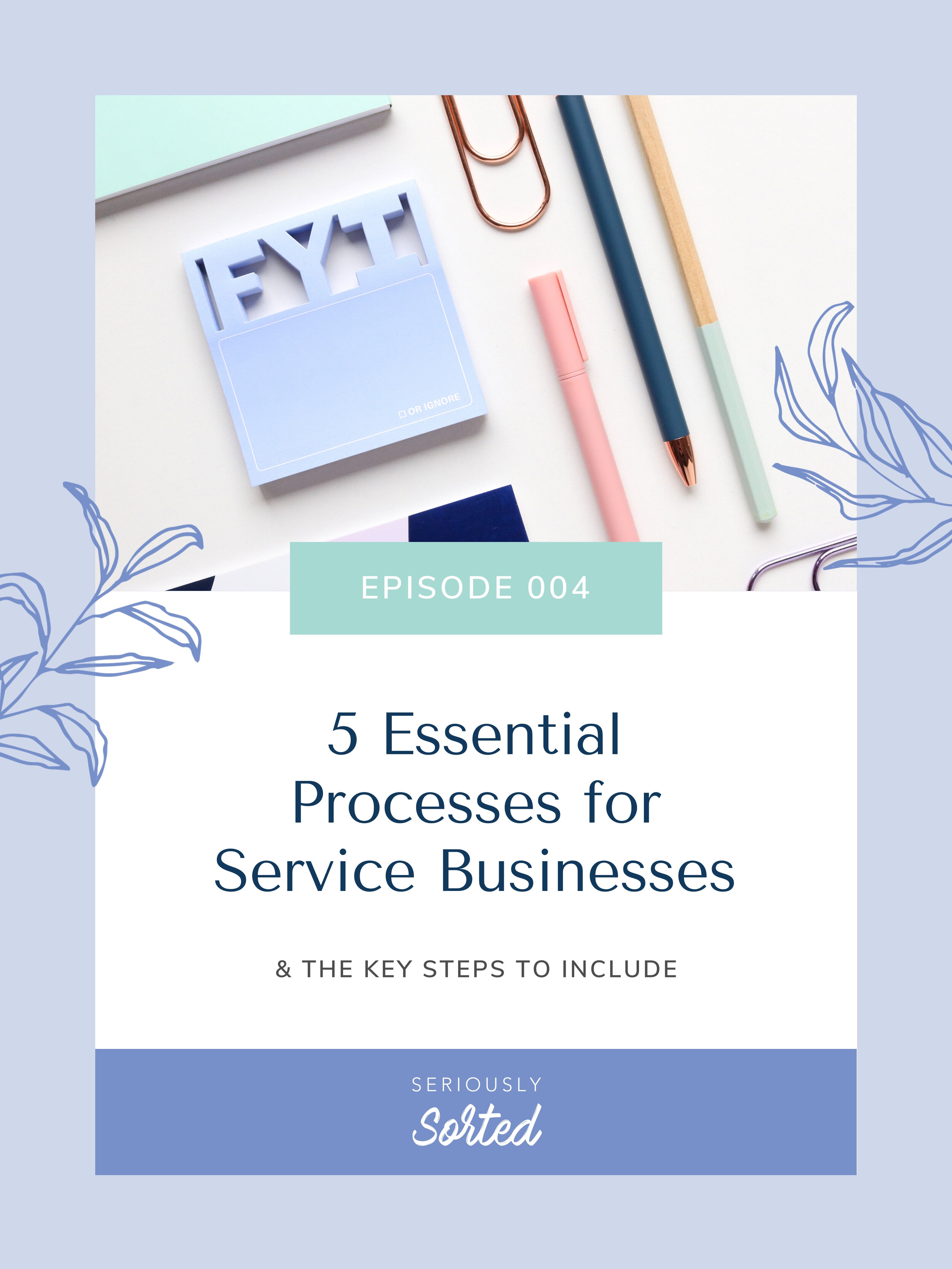5 Essential Processes for Service Businesses
Episode 004
Subscribe
Points Covered
The attributes of a good process
5 essential processes for service based businesses
Episode Transcript
Welcome to Episode 4 of The Seriously Sorted Podcast.
Wow, what an amazing week I have had, I've just been through launch week for the podcast, and I have to say, I've been *blown away* with the support from everybody, the reviews that have been left and just the overall well wishes. So thank you so much.
So today we are talking about the five essential processes that you need for your service based business. Now, what I talk about can definitely be applied to product based businesses, but I will be talking about it in a service based business context and using service based business examples. Now if you're out there listening and thinking, Lauren, I don't have any processes in my business, I can assure you that that is not the case. You definitely have processes already in your business, but they might simply be not documented or inconsistent. So this would be a good segue for me to suggest going back to Episode 3 and having a listen as to the six reasons you should document your processes in your business.
the attributes of a good process
Okay, so firstly, let's talk about the attributes of a good process. A good process should be easy to follow for you and the client, the client should understand where they are in the process at any point in time. You want to eliminate as much back and forth as possible. And when I do this work with my clients, I like them to think about the path of least resistance. So what I mean by that is how this will work if it all ran smoothly, and if clients didn't reschedule or forget appointments and things like that because your ideal client will follow your path of least resistance.
1: Enquiry process
Okey dokey. The first process we're going to talk about is your Enquiry process. So this is from when a customer first makes contact with you and enquires with you right up until when they agree to start working with you. The first thing to consider is how do you actually want to be contacted? Lots of times people will enquire via email, via DM, via phone, via text and a whole range of other things. Have a think about whether ideally you want to try and funnel everybody for example through to your contact form in your website. So if someone DMs you, do you still want to say thanks so much for your enquiry, please submit your details via my contact form on my website. Ideally, we want one point of reference for us to use when we're trying to manage all of our enquiries.
Next, we want to consider what details do we need from this potential client in order for us to 1. make an informed decision about whether we want to work with them and 2. in order for us to prepare a proposal for them. So consider whether you can collect the information you need purely in a contact form or perhaps a further questionnaire, or whether you do want to have some kind of enquiry call with your potential client.
2: onboarding process
The next process is your Onboarding process. So this is from when a client agrees to work you, right up until just before you start actually executing the service that they've employed you for. So the types of things we want to consider whether we include in our onboarding process include whether we need to collect more information from the client, whether we'd like a deposit upfront for the service, whether there's any documentation that we'd like the client to sign, such as a client agreement or a nondisclosure agreement. And just generally whether there's any pre work that we need the client to do, before we can start our work.
It's really important to consider the onboarding process, because often I see my clients skip right over this process purely out of, I guess, excitement in a way to be working with their ideal client. They skip right through from yes, the client agrees to work with them to yep, let's book you into start working together next week. And the pitfall with this is we don't necessarily consider what we need during the onboarding process and how long that might actually take. So we want to make sure that everybody has what they need in order for the experience to be great for you and the client.
3: Service Delivery Process
So this brings me to the essential process number three, which is your Service Delivery. And this for me, definitely does not start until everything in onboarding has been completed. This for me is a really hard and fast rule not just for myself, but for my clients, particularly those clients who are in fields such as graphic design, copywriting, website design where they really do need a whole lot of pre work done from their client in order for them to effectively and efficiently execute the service delivery.
Now at this point, you're going to know your service delivery better than I am. But a couple of things to consider is if you are in one of those more creative roles where you might send different versions of something to a client, so you might send a draft of your copywriting work or round one of a web design, definitely have a think at this point, how many different rounds of changes are included in your service, and what might be over and above or out of scope of your service delivery. For these types of businesses to also consider timeframes. So timeframes on when you will deliver the first round of something, timeframes on how long the client has to come back to you with their feedback. And this also applies to industries like business coaching. So think about timeframes with regards to how long does someone have to reschedule an appointment? So if it's within 24 hours, is there a charge for example, if it's within 48 hours, that's okay. Have a think about, again, how you can manage your time best and what you need from your client.
Now, when I'm going through this service delivery component with my clients, we usually get to the end of it, have a look, and think, have we forgotten something? And hands down, if we have forgotten something it is usually this: final payment. Please, please, please remember to incorporate final payment into your service delivery. Now that might sound really obvious, but I can't tell you how many times as a client, I've had to actually ask the service provider for a final invoice and it's often after they've finished their service. Now, I really encourage people in industries like the creative services like web design and things like that to please collect payment before final delivery of the website, of the finished photos, of the final copy.
Okay, so we've executed the service brilliantly, and the client is super happy. Is that the end of everything? I'm going to argue, no. If you've ever been in a situation where a client emails you after service delivery and says, "so is that it?" then you know you've missed this fourth essential process…
4: Offboarding Process
which is Offboarding. Now offboarding does not have to be a lengthy process. Basically, we just want everything to come to a really nice close and have a think about these things. No different onboarding, do we are the client need any further information before we close off the job. So does the client need a supporting documentation in order to utilise the photos that we've provided? Is there a maintenance period that comes along with us creating someone's website. And for us, this is the vital point where we collect our constructive feedback from the client on our service and hopefully, if all goes well, a testimonial.
4: Re-engagement Process
Which brings us to the final essential process number five, which is Re-engagement. Now, this will definitely be different for everybody. But what we want to do is have a think about what are the opportunities to naturally reengage our client with our service. Now for some people, this may be as simple as a follow up email just to check in to see how people are going in a few weeks to a few months time. For others, there might be a natural progression to move on to your next service that you offer and to reengage people that way. Either way, we all know that it is far easier to re engage an existing client than to obtain a new one. So having this step is so very valuable.
So there you have it, we've got our five essential processes:
Enquiry
Onboarding
Service Delivery
Offboarding
Re-engagement.
your podcast hostess
Lauren Stratford
I’m Lauren and I help overwhelmed creatives like you embrace their strengths, get clear on their customer journey and maximise their impact (without adding to the never ending task list!).
The Seriously Sorted Podcast® is a registered trademark.


